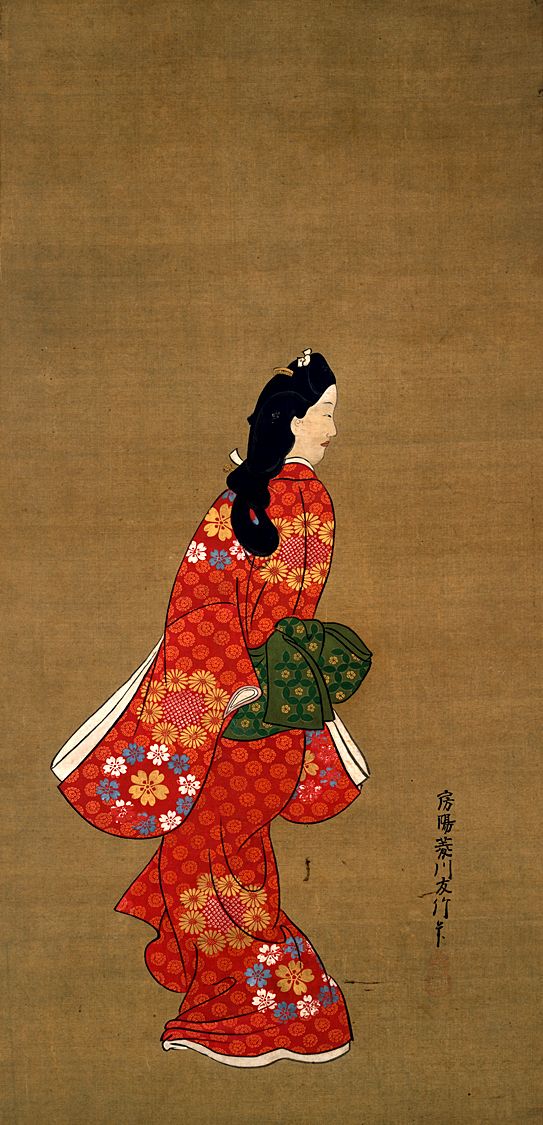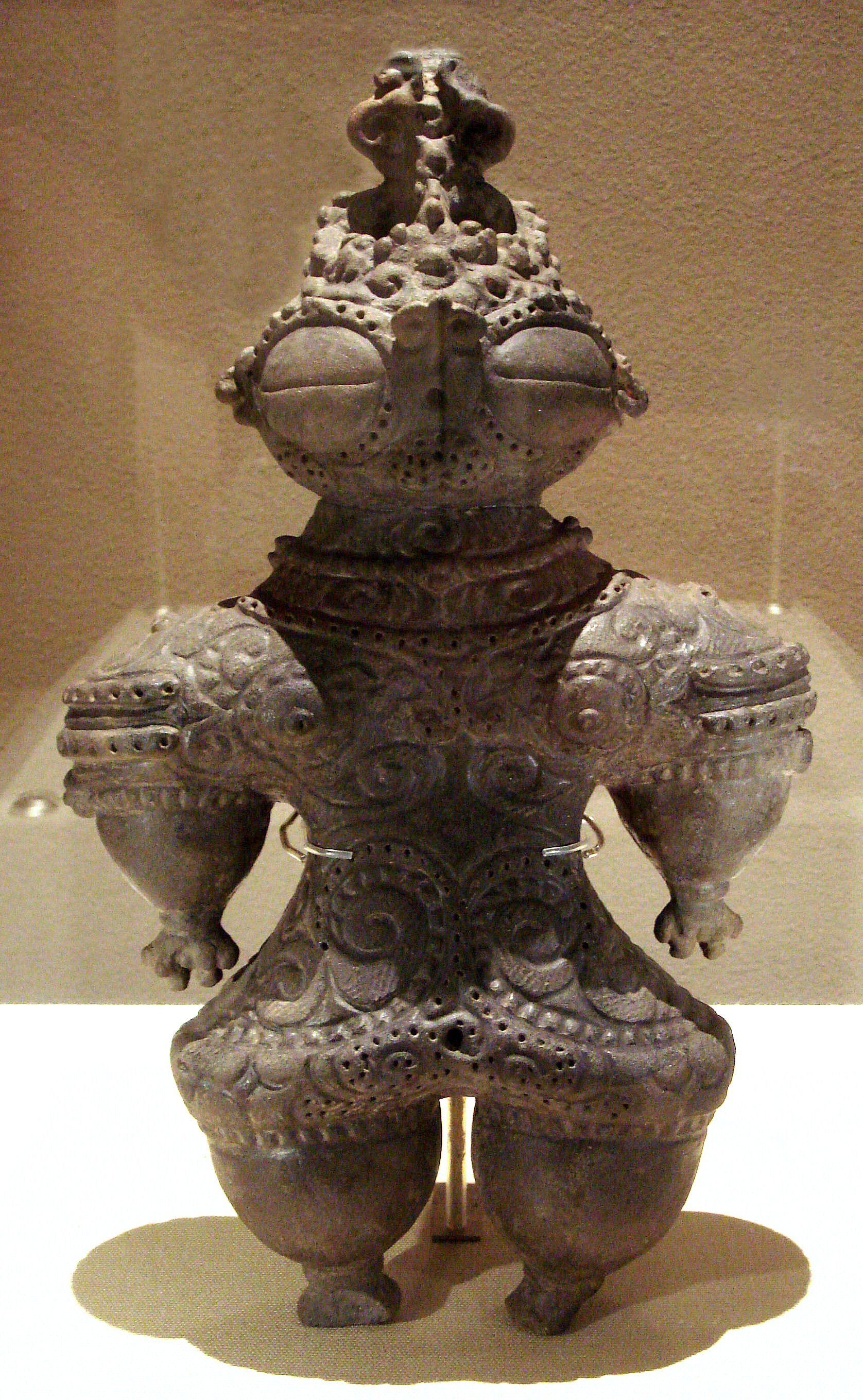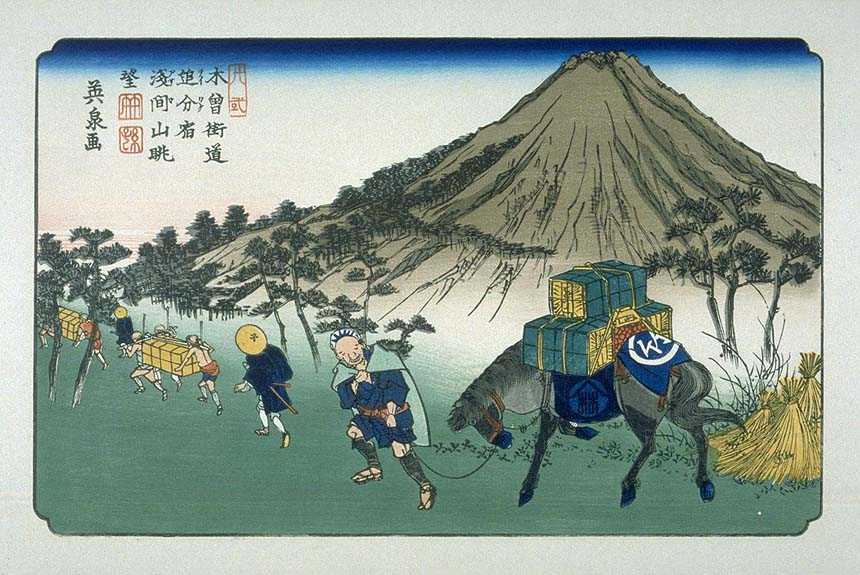|
Ukiyo-e
is a genre of Japanese art that flourished from the 17th through 19th centuries. Its artists produced woodblock printing, woodblock prints and Nikuhitsu-ga, paintings of such subjects as female beauties; kabuki actors and sumo wrestlers; scenes from history and folk tales; travel scenes and landscapes; Flora of Japan, flora and Wildlife of Japan#Fauna, fauna; and Shunga, erotica. In 1603, the city of Edo (Tokyo), Edo (Tokyo) became the seat of the ruling Tokugawa shogunate. The class (merchants, craftsmen and workers), positioned at the bottom of Four occupations, the social order, benefited the most from the city's rapid economic growth. They began to indulge in and patronize the entertainment of kabuki theatre, geisha, and oiran, courtesans of the Yūkaku, pleasure districts. The term ('floating world') came to describe this hedonistic lifestyle. Printed or painted ukiyo-e works were popular with the class, who had become wealthy enough to afford to decorate their homes wit ... [...More Info...] [...Related Items...] OR: [Wikipedia] [Google] [Baidu] |
Sharaku
was a Japanese ukiyo-e print designer, known for his portraits of kabuki actors. Neither his true name nor the dates of his birth or death are known. His active career as a woodblock artist spanned ten months; his prolific work met disapproval and his output came to an end as suddenly and mysteriously as it had begun. His work has come to be considered some of the greatest in the ukiyo-e genre. Sharaku made mostly ''yakusha-e'' portraits of kabuki actors. His compositions emphasize poses of dynamism and energy, and display a realism unusual for prints of the time—contemporaries such as Utamaro represented their subjects with an idealized beauty, while Sharaku did not shy from showing unflattering details. This was not to the tastes of the public, and the enigmatic artist's production ceased in the first month of 1795. His mastery of the medium with no apparent apprenticeship has drawn much speculation, and researchers have long tried to discover his true identity—among ... [...More Info...] [...Related Items...] OR: [Wikipedia] [Google] [Baidu] |
Utamaro
was a Japanese artist. He is one of the most highly regarded designers of ukiyo-e woodblock prints and paintings, and is best known for his ''Bijin-ga, bijin ōkubi-e'' "large-headed pictures of beautiful women" of the 1790s. He also produced nature studies, particularly illustrated books of insects. Little is known of Utamaro's life. His work began to appear in the 1770s, and he rose to prominence in the early 1790s with his portraits of beauties with exaggerated, elongated features. He produced over 2000 known prints and was one of the few ukiyo-e artists to achieve fame throughout Japan in his lifetime. In 1804 he was arrested and manacled for fifty days for making illegal prints depicting the 16th-century military ruler Toyotomi Hideyoshi, and died two years later. Utamaro's work reached Europe in the mid-nineteenth century, where it was very popular, enjoying particular acclaim in France. He influenced the European Impressionism, Impressionists, particularly with h ... [...More Info...] [...Related Items...] OR: [Wikipedia] [Google] [Baidu] |
Hokusai
, known mononymously as Hokusai, was a Japanese ukiyo-e artist of the Edo period, active as a painter and printmaker. His woodblock printing in Japan, woodblock print series ''Thirty-Six Views of Mount Fuji'' includes the iconic print ''The Great Wave off Kanagawa''. Hokusai was instrumental in developing ''ukiyo-e'' from a style of portraiture largely focused on courtesans and actors into a much broader style of art that focused on landscapes, plants, and animals. His works had a significant influence on Vincent van Gogh and Claude Monet during the wave of Japonisme that spread across Europe in the late 19th century. Hokusai created the monumental ''Thirty-Six Views of Mount Fuji'' as a response to a domestic travel boom in Japan and as part of a personal interest in Mount Fuji. It was this series, specifically, ''The Great Wave off Kanagawa'' and ''Fine Wind, Clear Morning'', that secured his fame both in Japan and overseas. Hokusai was best known for his woodblock ukiyo-e p ... [...More Info...] [...Related Items...] OR: [Wikipedia] [Google] [Baidu] |
Hokusai (1828) Cuckoo And Azaleas
, known mononymously as Hokusai, was a Japanese ukiyo-e artist of the Edo period, active as a painter and printmaker. His woodblock print series '' Thirty-Six Views of Mount Fuji'' includes the iconic print ''The Great Wave off Kanagawa''. Hokusai was instrumental in developing ''ukiyo-e'' from a style of portraiture largely focused on courtesans and actors into a much broader style of art that focused on landscapes, plants, and animals. His works had a significant influence on Vincent van Gogh and Claude Monet during the wave of Japonisme that spread across Europe in the late 19th century. Hokusai created the monumental ''Thirty-Six Views of Mount Fuji'' as a response to a domestic travel boom in Japan and as part of a personal interest in Mount Fuji. It was this series, specifically, ''The Great Wave off Kanagawa'' and '' Fine Wind, Clear Morning'', that secured his fame both in Japan and overseas. Hokusai was best known for his woodblock ukiyo-e prints, but he worked in a ... [...More Info...] [...Related Items...] OR: [Wikipedia] [Google] [Baidu] |
Japanese Art
Japanese art consists of a wide range of art styles and media that includes Jōmon pottery, ancient pottery, Japanese sculpture, sculpture, Ink wash painting, ink painting and Japanese calligraphy, calligraphy on silk and paper, Ukiyo-e, paintings and Woodblock printing in Japan, woodblock prints, Japanese pottery and porcelain, ceramics, origami, bonsai, and more recently manga and anime. It has a long history, ranging from the beginnings of human habitation in Japan, sometime in the 10th millennium BCE, to the present day. Japan has alternated between periods of exposure to new ideas, and long periods of minimal contact with the outside world. Over time the country absorbed, imitated, and finally assimilated elements of foreign culture that complemented already-existing aesthetic preferences. The earliest complex art in Japan was produced in the 7th and 8th centuries Buddhist art in Japan, in connection with Buddhism. In the 9th century, as the Japanese began to turn awa ... [...More Info...] [...Related Items...] OR: [Wikipedia] [Google] [Baidu] |
Utagawa Kuniyoshi
Utagawa Kuniyoshi (, ; 1 January 1798 – 14 April 1861) was one of the last great masters of the Japanese ukiyo-e style of woodblock prints and painting.Nussbaum, Louis Frédéric ''et al'' (2005). "Kuniyoshi" in He was a member of the Utagawa school.Nussbaum, "Utagawa-ryū" in The range of Kuniyoshi's subjects included many genres: landscapes, women, Kabuki actors, cats, and mythical animals. He is known for depictions of the battles of legendary samurai heroes.Lubow, Arthur "Everything But the Robots: A Kuniyoshi Retrospective Reveals the Roots of Manga,"''New York Magazine.'' March 7, 2010. His artwork incorporated aspects of Western representation in landscape painting and caricature. Life Kuniyoshi was born on 1 January 1798, the son of a silk-dyer, Yanagiya Kichiyemon,Robinson (1961), p. 5 originally named Yoshisaburō. Apparently he assisted his father's business as a pattern designer, and some have suggested that this experience influenced his rich use of color and ... [...More Info...] [...Related Items...] OR: [Wikipedia] [Google] [Baidu] |
Hiroshige
or , born Andō Tokutarō (; 1797 – 12 October 1858), was a Japanese ''ukiyo-e'' artist, considered the last great master of that tradition. Hiroshige is best known for his horizontal-format landscape series '' The Fifty-three Stations of the Tōkaidō'' and for his vertical-format landscape series '' One Hundred Famous Views of Edo''. The subjects of his work were atypical of the ''ukiyo-e'' genre, whose typical focus was on beautiful women, popular actors, and other scenes of the urban pleasure districts of Japan's Edo period (1603–1868). The popular series '' Thirty-six Views of Mount Fuji'' by Hokusai was a strong influence on Hiroshige's choice of subject, though Hiroshige's approach was more poetic and ambient than Hokusai's bolder, more formal prints. Subtle use of color was essential in Hiroshige's prints, often printed with multiple impressions in the same area and with extensive use of '' bokashi'' (color gradation), both of which were rather labor-intensive ... [...More Info...] [...Related Items...] OR: [Wikipedia] [Google] [Baidu] |
Hishikawa Moronobu
Hishikawa Moronobu (; 1618 – 25 July 1694) was a Japanese artist known for popularizing the ukiyo-e genre of woodblock prints and paintings in the late 17th century. He consolidated the works of scattered Japanese art styles and forged the early development of ukiyo-e. Early life Born in Hoda at the distant end of Edo Bay, Moronobu was the son of a well-respected embroiderer of rich tapestries who produced them for the use of temples and wealthy patrons. His initial works consisted designs for embroidery. After moving to Edo in the 1660s, Moronobu, who had likely learned skills from his father's craft, and studied both Tosa and Kanō-style painting. He thus had a solid grounding in both decorative crafts and academic painting, which served him well when he then turned to ukiyo-e, which he studied with his mentor, the Kanbun Master. Work The earliest known illustration of Moronobu that can be dated comes from his work titled ''One Hundred Warrior Poets'' from 167 ... [...More Info...] [...Related Items...] OR: [Wikipedia] [Google] [Baidu] |
Shunga
is a type of Japanese erotic art typically executed as a kind of ukiyo-e, often in Woodcut, woodblock print format. While rare, there are also extant erotic painted handscrolls which predate ukiyo-e. Translated literally, the Japanese word ''shunga'' means ''picture of spring''; "spring" is a common euphemism for sex. Shunga, as a subset of ukiyo-e, was enjoyed by all social groups in the Edo period, despite being out of favor with the shogunate. The ukiyo-e movement sought to idealize contemporary urban living and appeal to the new chōnin class. Shunga followed the aesthetics of everyday life and widely varied in its depictions of sexuality. Most ukiyo-e artists made shunga at some point in their careers. History Shunga was heavily influenced by illustrations in Chinese medicine manuals beginning in the Muromachi era (1336 to 1573). Zhou Fang (Tang Dynasty), Zhou Fang, a notable Tang dynasty, Tang-dynasty Chinese painter, is also thought to have been influential. He, li ... [...More Info...] [...Related Items...] OR: [Wikipedia] [Google] [Baidu] |
Okumura Masanobu
Okumura Masanobu (; 1686 – 13 March 1764) was a Japanese print designer, book publisher, and painter. He also illustrated novelettes and in his early years wrote some fiction. At first his work adhered to the Torii school, but later drifted beyond that. He is a figure in the formative era of ukiyo-e doing early works on actors and bijin-ga ("pictures of beautiful women"). Life and career While Masanobu's early life is largely undocumented, he is believed to have been born about 1686, possibly in Edo (modern Tokyo). Edo was a small fishing village when Tokugawa Ieyasu chose it as his administrative capital of the Tokugawa shogunate, and by the early 17th century the city had prospered and its population had grown to half a million. Masanobu appears to have been self-taught painter (though he did study poetry under Tachiba Fukaku); he is not known to have belonged to any artistic school. His early work shows the influence of the Torii school of ukiyo-e painting, particularly ... [...More Info...] [...Related Items...] OR: [Wikipedia] [Google] [Baidu] |
Ukiyo
is the Japanese term used to describe the urban lifestyle and culture, especially the pleasure-seeking aspects, of Edo period Japan (1600–1867). Ukiyo culture culture developed in Yoshiwara, the licensed red-light district of Edo (modern-day Tokyo), the site of many brothels frequented by Japan's growing middle class. A prominent author of the genre was Ihara Saikaku, who wrote '' The Life of an Amorous Woman''. culture also arose in other cities, such as Osaka and Kyoto. This middle class, newly rich merchants known as chōnin, were unable to move up the social ladder due to the segregated class system imposed by the Tokugawa shogunate during the Edo period. Chōnin were the lowest class of four, below warriors, farmers and artisans. Due to being economically powerful but socially confined, their assets were turned to conspicuous consumption, arts and culture. The term in medieval Japan was associated with Buddhism and meant "this transient, unreliable world". ... [...More Info...] [...Related Items...] OR: [Wikipedia] [Google] [Baidu] |
Geisha
{{Culture of Japan, Traditions, Geisha {{nihongo, Geisha{{efn, {{IPAc-en, lang, ˈ, ɡ, eɪ, ., ʃ, ə, {{IPA, ja, ɡei.ɕa, ɡeː-, lang{{cite book, script-title=ja:NHK日本語発音アクセント新辞典, publisher=NHK Publishing, editor=NHK Broadcasting Culture Research Institute, date=24 May 2016, lang=ja, 芸者, also known as {{nihongo, , 芸子, geiko{{efn, {{IPA, ja, ɡei.ko, ɡeː-, lang, {{citation needed span, in Kyoto and Kanazawa, date=May 2025 or {{nihongo, , 芸妓, geigi{{efn, {{IPA, ja, ɡeꜜi.ɡi, ɡeꜜː-, -ŋi, lang , are female Japanese people, Japanese performing arts, performing artists and entertainers trained in performing arts#Japan, traditional Japanese performing arts styles, such as Japanese traditional dance, dance, Music of Japan, music and singing, as well as being proficient conversationalists and hosts. Their distinct appearance is characterised by long, trailing kimono, nihongami#geisha, traditional hairstyles and {{transliteration, ja, o ... [...More Info...] [...Related Items...] OR: [Wikipedia] [Google] [Baidu] |












